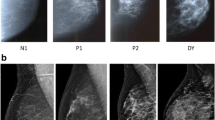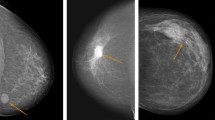Summary
Ninety-two women with advanced, unilateral breast cancer were classified according to the Wolfe and Nottingham classifications of mammographic parenchymal pattern (MPP). Both classifications of MPP were significantly correlated to the estrogen receptor (ER) status of the breast carcinoma, but could not be used for prediction of response to hormonal therapy. Age distribution was significantly different among Wolfe types as well as between ER groups, but a multiple regression analysis showed that both age and Wolfe pattern were significant and independent predictors of the ER status.
Similar content being viewed by others
References
Nielsen NSM, Poulsen HS: Relation between mammographic findings and hormonal receptor content in breast cancer. Am J Roentgenol 145: 501–504, 1985
Broberg A, Glas U, Gustafsson SA, Hellstrom L, Somell A: Relation between mammographic pattern and estrogen receptor content in breast cancer. Breast Cancer Res Treat 3: 201–207, 1983
Hinton CP, Roebuck EJ, Williams MR, Blamey RW, Glaves J, Nicholson RI, Griffiths K: Mammographic parenchymal patterns: Value as a predictor of hormone dependency and survival in breast cancer. Am J Roentgenol 144: 1103–1107, 1985
Ciatto S, Cecchini S, Iossa A, Grazzini G, Messeri G, Valenti L, Nunzi G, Bartolucci R, Costanzo FD: Association of estrogen receptors with parenchymal pattern at mammography. Radiology 170: 695–697, 1989
Wolfe JN: Risk for breast cancer development determined by mammographic parenchymal pattern. Cancer 37: 2486–2492, 1976
Roebuck EJ: The importance of mammographic parenchymal patterns. Br J Radiol 55: 387–398, 1982
Hayward JL, Carbone PP, Heuson J-C, Kumaoka S, Segaloff A, Rubens RD: Assessment of response to therapy in advanced breast cancer. Eur J Cancer 13: 89–94, 1977
Andersen J, Ørntoft TE, Poulsen HS: Immunohistochemical demonstration of estrogen receptors (ER) in formalin-fixed paraffin-embedded human breast cancer tissue by use of a monoclonal antibody to ER. J Histochem Cytochem 36: 1553–1560, 1988
Boyd NF, Fishell E, Tonkin K, Mobbs BG: Age as a confounding factor in the association of mammographic dysplasia and estrogen receptor concentration in breast cancer. Breast Cancer Res Treat 10: 51–54, 1987
Author information
Authors and Affiliations
Rights and permissions
About this article
Cite this article
Nielsen, N.S.M., Andersen, J., Poulsen, H.S. et al. Prediction of hormone responsiveness by mammographic parenchymal pattern in advanced primary breast cancer. Breast Cancer Res Tr 23, 219–222 (1992). https://doi.org/10.1007/BF01833518
Issue Date:
DOI: https://doi.org/10.1007/BF01833518




